Your web hosting and a swing dance event don’t have the most obvious of connections. However, there’s a critical rule during an event that everyone has to follow: “One dance at a time.” In other words, focus on one dance before moving on to the next one. That also explains why it’s a good idea to keep your email and hosting separate.
Any web host worth its salt wants to provide top-notch server infrastructure and rock-solid security to its customers. As such, providing other (but related) services such as email may dilute the core offering. While that may not be the only factor, it’s still a large one.
Given this, we’re going to delve into why you should keep email and hosting separate. We’ll discuss why Kinsta doesn’t offer email hosting, and then round up a few excellent email hosting providers. What’s more, we’ll also take you on a whistle-stop tour of how to set up your own email server.
Let’s get started!
Importance of Email for Both Personal and Business Use
Quick pop quiz: What’s the one way to guarantee someone will receive your correspondence?
A letter could get lost, phone calls sometimes go missing into the ether, and the recipient could be hiding behind the couch when you knock on their door.
The answer is email.
Yes, there’s a chance that an email drops into the spam folder, but it’s still gotten to your recipient, just in a different folder than the inbox. Regardless, that’s not something you can control.
Even with the advent of instant messaging channels and social media, email is still a successful method of reaching people. Despite the similarities between instant platforms, email is more direct — it’s electronic mail, after all. And it’s universal.
The data bears this out. Current figures suggest there are around 4 billion email users across the globe. That’s about the same number as WhatsApp, Facebook Messenger, Telegram, and Snapchat combined.
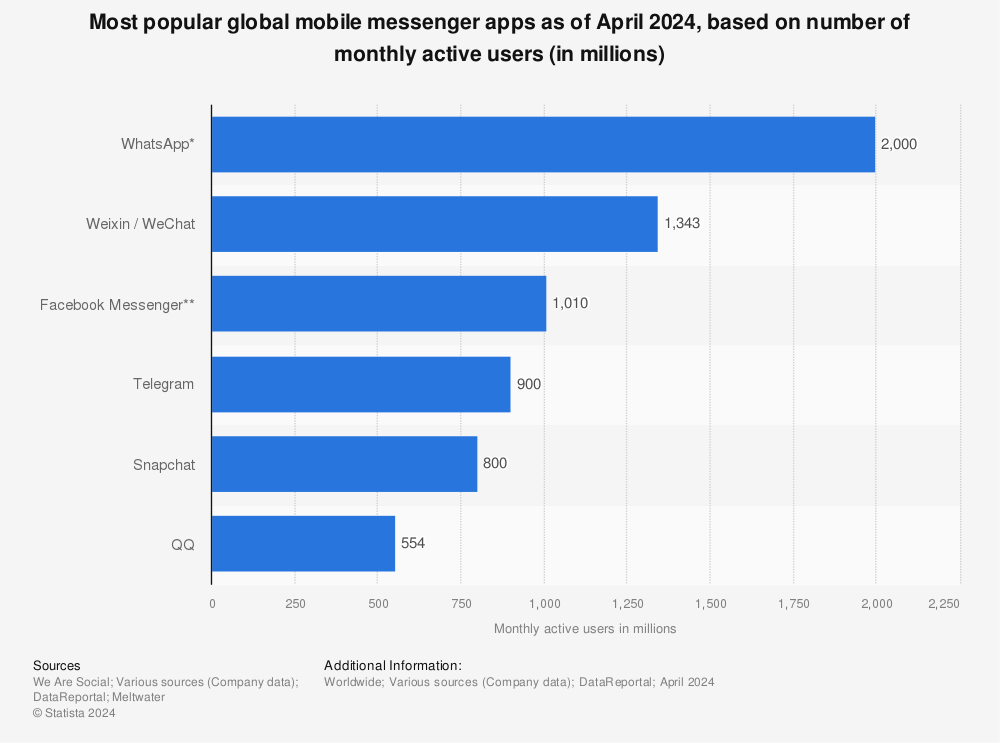
What’s more, the number of email user accounts looks like it will continue to rise in the future. Given that email has a 90% penetration rate, it’s going to stick around for a long time.
Why Kinsta Doesn’t Provide Email Hosting (While Some Hosts Do)
Because of these statistics, it’s easy to see why a hosting company might choose to offer email alongside its primary services.
In the end, email delivery and deliverability are within a host’s wheelhouse. These facets use the sending domain and IP for verification and checking purposes — ideal for a web host. After all, who’s better than a web expert to ensure that
information reaches its recipients quickly and accurately?
There might be better options.
Your web host isn’t going to be an expert in all aspects of email hosting. For this reason, Kinsta doesn’t offer email hosting. We talk about this elsewhere on the Kinsta site, but let’s give you a summary as to why this is:
All of our resources are committed to making Kinsta the best application, database, and managed WordPress hosting platform in the industry.
The above quote should tell you everything you need to know. Our approach is successful, and we understand that while Kinsta provides stellar hosting for WordPress websites, a solution such as Google Workspace does just the same for email hosting.
Why attempt to reinvent the wheel when we can focus on what we’re great at? Plus, that gives our customers better options — a win-win for everyone!
Why You Should Keep Email and Hosting Separate
While there are many personal reasons you should keep email and hosting separate, there are many technical reasons.
For starters, resource usage is one big plus point in that you won’t churn through your bandwidth and storage provisions. Also, you can dedicate those resources to the elements related to hosting your site rather than siphoning some off for your email accounts.
It works the other way around, too. Your email hosting has its own dedicated resources without another service having an impact. Syncing these accounts is just as straightforward as a combined provider in most cases.
It has a knock-on effect with the reliability of both platforms: Each service is responsible for one job and can channel time and dedication to make sure both stay rock-solid. However, it could be that one of your host or email providers isn’t as stellar as the other. That’s understandable when you involve budgets.
In this sort of situation, it could be that you go with a combined provider. However, if either the email or the hosting goes down, it will often take the other with it. That could be disastrous for any business that relies on online communication — perhaps the most important reason.
Speaking of business, there’s a time-saving benefit of separating email and web hosting. If you decide that one service isn’t for you or that you want to up sticks for a better service, it’s simple to do so without affecting the other half of your business.
If you’re tied in two ways with a combined provider, it’s harder to break those chains. Hence, you’re better off with independent providers for email and hosting.
6 Great Email Hosting Providers
At this point, you’re likely nodding your head and are ready to banish your combined email and web hosting. First, though, you’ll need a suitable email provider.
The following six solutions all work great with a separate host, though we’ll talk about them in more detail over the following few sections. Using any of these allows you to keep email and hosting separate.
1. Google Workspace

First off, we have Google Workspace. It’s a familiar service to millions of users, not only for its quality email provision. As the name suggests, it’s a whole suite of tools and apps to help you carry out your day-to-day work (though we’re focusing on email here).

Gmail is (of course) the email hosting portion of Workspace. It’s a longstanding service for Google, and right from the off, it nailed what email should be about. You can use one-key shortcuts to carry out almost every action, making chopping down a hefty inbox a breeze. We appreciate the Vim-like navigation shortcuts for getting around your inbox.
It’s not an exaggeration to say that Gmail redefined much of what email is to many. Almost every provider now uses an Archive folder to put old emails away, and most include Gmail-inspired color tags and labels to mark specific emails for later. The old folder system of the past is almost obsolete now, all thanks to Gmail’s prevalence.
Because Kinsta runs on the Google Cloud Platform, you also get better integration with Workspace apps too. It’s something we’ll talk more about later, but if you’re a Kinsta user, you can “auto-apply” MX records for your chosen domain.
On the whole, Gmail has almost everything going for it:
- It’s secure, and it’s now ad-free for everyone.
- You have a great set of keyboard shortcuts that other apps now also use.
- Google gives you a 99.9% guaranteed uptime and “zero percent downtime planned.” It’s a service that’s always on.
- You can use Gmail for business or personal accounts.
- There are plenty of integrations with the rest of Google Workspace, such as Google Meet, Google Calendar, and every other type of business-oriented app on a practical level.
The pricing is excellent, too. The tiers range from $6 to $12 per user, though 30 GB of cloud storage per user is perfect for the majority.
We’ll be honest and say that if you’re not already using Google Workspace, it’s not by accident. However, we suggest you check it out again if you’re not a current customer. It could be the best purchase for your business all year.
2. Microsoft Outlook
You can’t say you’re an old-school internet user if you’ve never used Hotmail. The classic free email client changed in 2011 to become Outlook, and with this change came a shift in focus to business applications.
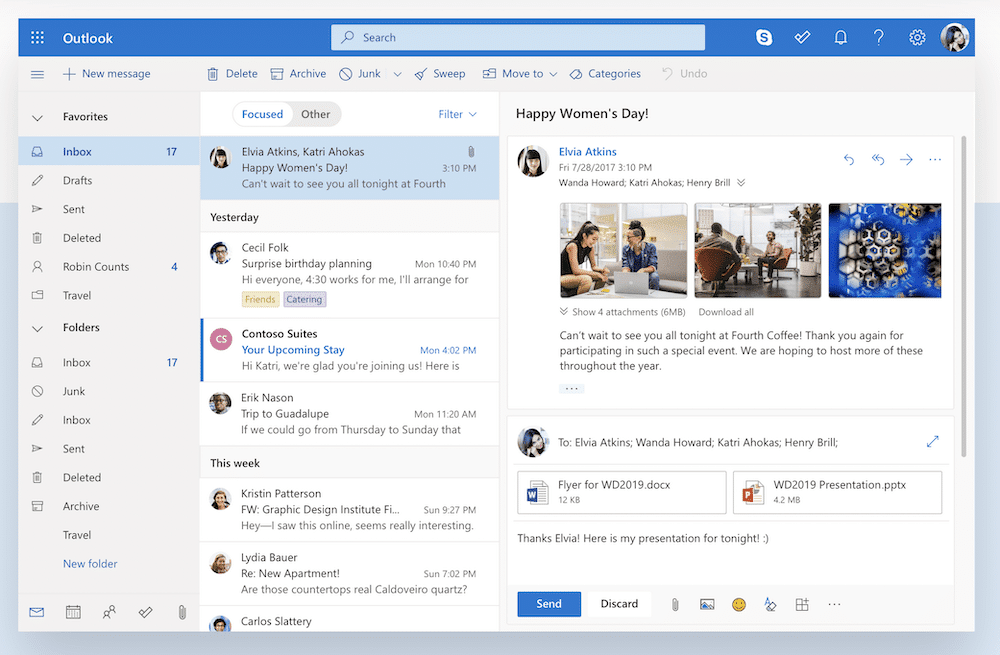
While Hotmail has a less-than-spotless reputation (one reason for the name change), Microsoft has worked hard to turn this throwaway free service into a respected business platform for hosting email. They run it in conjunction with the Microsoft 365 cloud-based service, and much like Google, you can integrate the entire suite of apps with your email.
The usual suspects such as calendars, task managers, and user profiles are all here. Everything stays in the cloud and uses your OneDrive account to sync across devices.
While a service such as Google doesn’t mention the security of its platform too much, Microsoft puts its enterprise-grade security front and center. It uses data encryption both on your mailbox and for sent items.
Outlook will also deactivate links that it detects are unsafe, such as malware or viruses. On top of that, you get ransomware detection, which is vital for a business, and OneDrive recovery options too.
Here’s a quick summary of what we like about Outlook:
- You get Microsoft’s nearly 25 years of experience as an email provider backing your business.
- The Outlook interface is appealing and offers a focused set of visuals.
- Your emails get security at an enterprise level, along with extra tools to combat scams, viruses, and more.
- There are a few built-in apps, too, such as a calendar and task manager. Even so, you can integrate Outlook with the whole suite of Microsoft 365 apps.
Its pricing gives other solutions a run for its money. At a core level, Outlook is 100% free. The whole Microsoft 365 suite is free. If you wish to go premium, there’s a competitive set of tiers to choose from. Most users will likely want either a $5 or $12 plan, depending on whether you’d use the remote working functionality.
On the whole, Outlook is a more functional tool that (much like Google, Zoho, and others) wants to keep you in its ecosystem. It does this by offering a set of great apps to manage your entire business. However, its email service is a frontrunner and likely will be for many years to come.
3. Zoho Mail
Hot on the heels of its email hosting solutions, Zoho also offers a broad range of apps to manage your business. However, its Mail service wins lots of new customers every day.

Zoho includes a staggering number of features to extend the whole functionality of its package. At a base level, the email client is a no-frills (though well-executed) app that looks a lot like Gmail and Outlook, but not quite. You get the standard integration of calendars, task lists, contact managers, and note-taking that adorn most other email clients.
However, the User Experience (UX) is at the forefront with Zoho Mail. You can tell this from the effort the team puts into its dashboard and general account management. For example, you can set up a custom domain to enable users to log in through a mail subdomain. That helps everyone know where to head for email.
Zoho Mail also uses restriction-based functionality for specific IP addresses. That means you can keep your email accounts more secure, as only a handful of users in a particular location can gain access. There are other fantastic user management tools, too, such as user role settings.
There’s more we could talk about with Zoho, but here’s a quick rundown:
- You have a functional client for sending and receiving emails.
- There are plenty of user and group management tools in the box, which means you can tailor the system to your requirements.
- Zoho provides a robust set of spam policy tools too, and it uses multiple validation protocols.
- Zoho Mail offers enterprise-level security to help keep your data safe.
- An exciting built-in tool is the eDiscovery portal. In short, this helps you keep tabs on your email retention policies and is a must for any business that has to adhere to privacy and data protection laws.
It’s staggering that Zoho Mail’s pricing is a snip compared to every other solution too. The top tier is around $4–5 per month per user, which, given the service’s feature set, means you’d be remiss not to at least investigate it.
Zoho has gained a lot of ground over the years and continues to do so. Given the quality of Zoho Mail, we can see why this is.
4. ProtonMail
From Zoho’s India, we head to Switzerland and ProtonMail. It’s is an open source email provider that values privacy above all else and is developed by a team of CERN engineers (and the birthplace of the web).

Switzerland has some of the strictest privacy laws in the world. As such, with ProtonMail’s servers and business in the country, your data is as safe as possible. It uses end-to-end encryption for your emails, and you can choose whether this is applied at the point of sending.
The web interface is friendly, though it lacks some functionality. You can connect the service to only a few external email clients, even if it accepts a ProtonMail Bridge connection. It’s a touch fiddly to set up, but the benefits of privacy far outweigh the negatives here.
What’s more, your data is so secure that even ProtonMail can’t recover your account if you lose your password. That’s scary, for sure. However, it also gives peace of mind that sensitive data is only for your eyes and clients (barring a few exceptions where law enforcement is involved).
Here’s what we think makes ProtonMail stand out:
- It offers the greatest level of privacy we’ve come across from an email provider.
- There’s proper end-to-end encryption for your emails, and you can even leverage it with Gmail, Yahoo, and others.
- The email web interface is good to use, albeit lacking in functionality in places.
- You have apps for both iOS and Android, and you can link ProtonMail to Outlook, Thunderbird, Apple Mail, and more through the ProtonMail Bridge software.
There are four different pricing plans for ProtonMail. The good news is there’s a free tier available, though this isn’t as stacked as other free email hosts’ offerings.
The other tiers are all priced reasonably; the Professional plan will be the most attractive. It’s $6.25 per month per user, and lets you use a custom domain, provides flexible storage management, and grants you advanced admin controls for your team.
5. Hover
If you’re unaware of Hover, let’s fill you in on the details. It fits in with our philosophy of “one dance at a time” because the company is all about domains. It’s a registrar that offers an insane number of top-level domain (TLD) extensions:
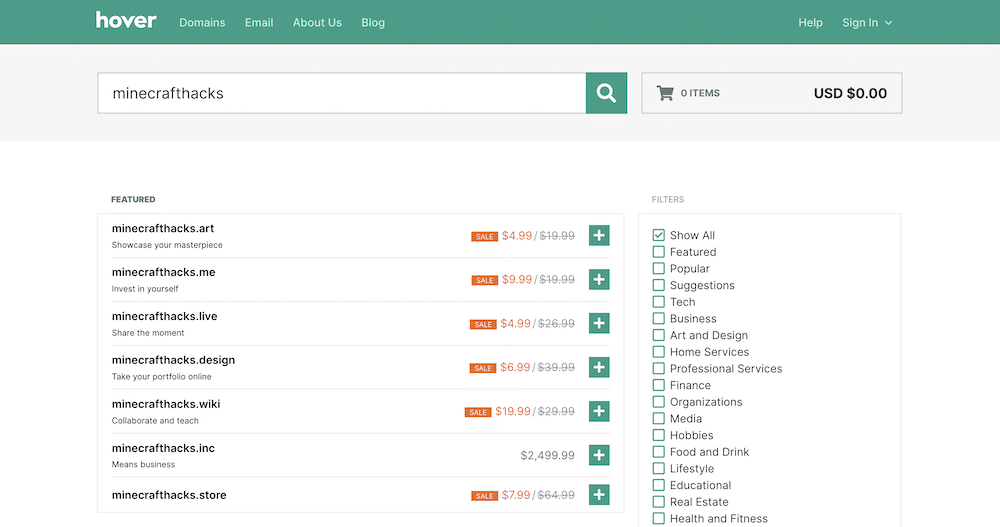
However, email fits in alongside domains much more comfortably than alongside hosting. That feels like a better match, and it helps that there are only two core services on offer.
The best thing about Hover is that it’s no-frills and no-fuss. You get a decent web client to check your emails, but you can also connect the service to your desktop or mobile client. One of the selling points is that you don’t have to change your workflow or practices to use Hover, which will appeal to many busy businesses.
Let’s give you a quick list of great points about Hover:
- It’s a straightforward service that gives you everything you need and nothing more.
- You can purchase your domain name and link your email to it from within Hover’s dashboard. The same goes for pricing, too, in that both your domain and email get billed simultaneously.
- You can add as many mailboxes as you need against a domain.
- Hover is a private, ad-free, tracker-free solution.
- It has a built-in spam checker and antivirus app.
As for pricing, there are two tiers: small mailbox and large mailbox. The small mailbox is 10 GB of storage for $20 per month, while the large mailbox is $29 for a whopping 1 TB storage. You can also use a “forward only” add-on that redirects any email meant for your domain address straight to your current email.
Hover will be perfect if you want to keep your domain and email separate from your hosting. After all, your domain-centric email addresses will also be unusable if your domain is down. That’s is true regardless of whether you use a separate provider. It doesn’t get in the way of your experience, and for straightforward business email, it will serve you well.
6. Mailgun
Mailgun is a solution we cover in our article on free SMTP servers. As such, we have a lot of knowledge and experience with the service.
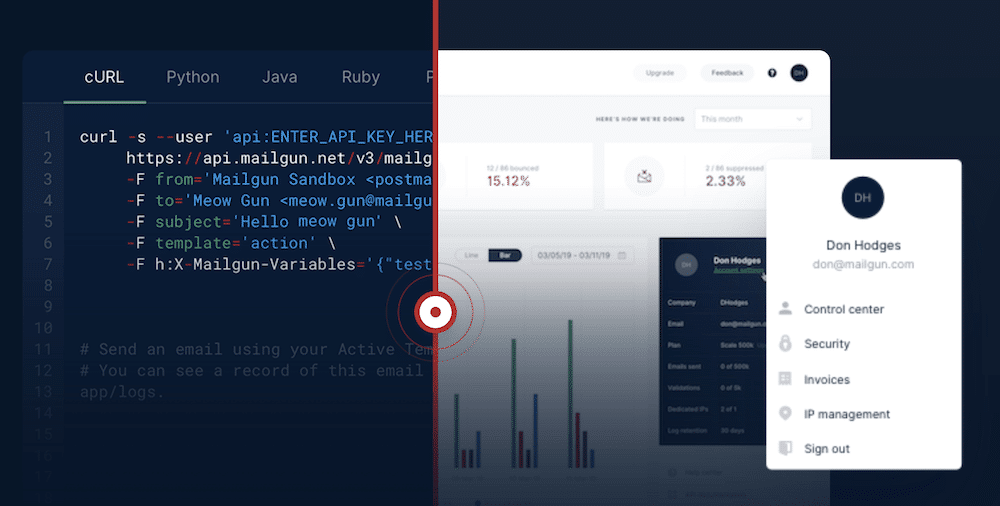
It’s a service based on an Application Programming Interface (API). You can connect with it using various programming languages, such as Python, Node.js, Java, and PHP.
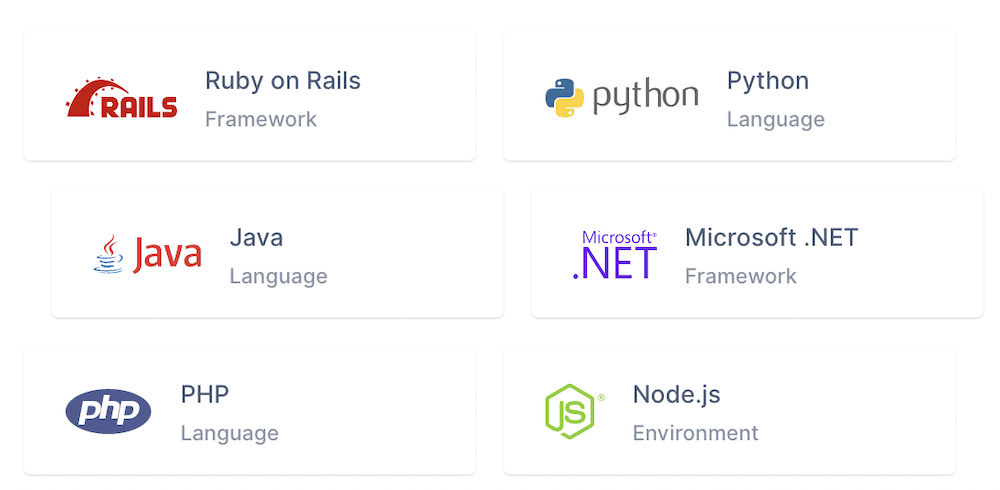
Mailgun is solid for transactional or bulk emailing as it can scale with the best. It works to improve your deliverability, and it offers good tools for rate management. We like how it includes an email template builder to help you draft canned responses and get back to business.
It helps that there’s also a wide range of variables to include within your emails too. That can give you a leg up when trying to personalize your emails.
We could wax lyrical about Mailgun all day long. You can read all about it in our dedicated article on how to set up Mailgun in WordPress. It’s worth a read to get more familiar with the platform.
That said, note that while Mailgun used to have a free tier, it no longer does. Instead, you get a generous three-month trial, with a pay-as-you-go rate of around $0.80 per 1,000 emails. As for the other tiers, you can choose from their $35, $80, or $90 tiers. More features are provided on each incremental tier while also upping the number of emails included in the plan.
If you send many transactional and marketing-related emails, Mailgun is an excellent option to keep email and hosting separate.
How to Set Up Your Email Server (Intro to MX Records)
Before we go, let’s give you a quick overview of how to set up your email server.
To set this up with WordPress, you’ll need a suitable SMTP plugin. What’s more, you’ll (of course) need an email provider.
If you’re going to opt for a solution such as Google Workspace, the process will be straightforward (or ready to go from the off). However, the process is more complex if you’re going for an SMTP service such as Mailgun.
Apart from our guide on using Mailgun, we also have a guide on using Google’s free SMTP server to send emails within WordPress. It could be that you also want to get your provider’s emails into your chosen client, such as Apple Mail or Outlook. We cover how to do this with Yahoo’s email service, and the process is similar to other providers.
The next step will be to set up your mail exchanger (MX) records. In a nutshell, this is how you get your emails to send from your domain name, so they’re essential. The process is often the same regardless of your domain registrar and hosting provider, so you’re in good hands no matter your final pick of providers.
Summary
Hosting providers offer superb infrastructure for your website, but sometimes they reach above their station. It’s logical to see why a web host might also offer email to customers. After all, those HTTP requests have to go somewhere, and who better than through your host?
At Kinsta, we think you should keep email and hosting separate. A host should concentrate on what it’s good at and dedicate its resources to provide the best service possible.
For email, you can choose from a fantastic array of email hosting services, such as Google Workspace, Hover, and Mailgun. Each one is simple to set up and connect with your domain name, website, and email client.
Do you think you should keep your email and hosting separate, or are you OK with combining them? Let us know what you think in the comments section below!



Hey team, this is a great piece!
I’m going to have this featured in our upcoming WP Buffs broadcast. Keep up the good work, partner!
Alec Wines, Head of Marketing and Sales at WP Buffs
Really very amazing blog! Thanks for sharing it with us.